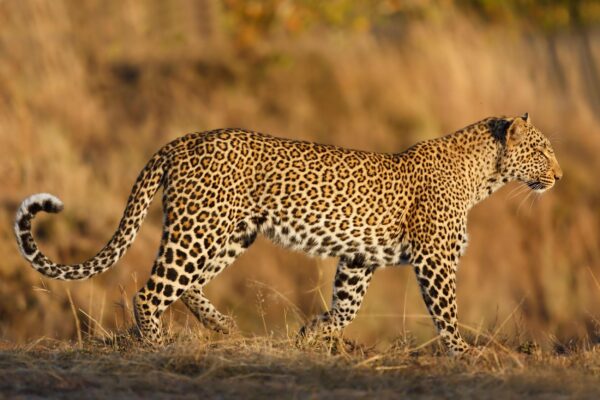Lion
The lion is the Serengeti’s emblematic apex predator and a profoundly social big cat: prides of related females hunt cooperatively while male coalitions defend territories. Their hunting strategy combines stealth, teamwork and explosive short-range power to bring down wildebeest, zebra and buffalo. Lions shape prey populations and the behaviour of other predators; cub survival depends on pride stability and prey abundance. Sightings range from languid daytime rest to dramatic nocturnal hunts, and watching pride dynamics — courtship, play, territorial patrolling and cub rearing — offers rare insight into complex feline social life.
Leopard
Leopards are solitary, stealthy ambush predators that thrive in the Serengeti’s mosaic of kopjes, riverine forest and scrub. Their cryptic rosette coats and secretive habits make sightings especially prized: they stalk at dawn and dusk, then often haul kills into trees to protect them from lions and hyenas. Opportunistic feeders, leopards take small to medium prey — from small antelope to monkeys — and adjust diet by habitat. Their ability to cling to steep terrain, climb with heavy carcasses and move silently under cover allows them to persist in areas where larger competitors dominate.
Cheetah
Cheetahs are the Serengeti’s speed specialists — lightweight, highly aerodynamic felines built for short, explosive sprints to catch fleet-footed prey. They hunt mainly by day, using stealth and sun-angled vantage points to approach before a rapid chase; non-retractile claws and flexible spines help with acceleration and traction. Because they rely on speed rather than brute force, failed chases are costly, and cubs face high predation risk from larger carnivores. Cheetah family groups and females with cubs exhibit careful habitat choices to find open ground for running while avoiding areas dense with lions or spotted hyenas.
African Elephant
Elephants are ecosystem engineers in the Serengeti: matriarchal herds travel seasonal routes to water and forage, felling trees, opening pathways and digging waterholes that benefit many other species. Their complex social bonds and long memories guide herd movements and resource use; low-frequency rumbles and body language coordinate group behaviour. Elephants influence vegetation structure, seed dispersal and nutrient cycling through their feeding and movements. Because of their size and intelligence they play a keystone role, but they also bring conservation challenges where human land use or poaching pressures overlap with migration corridors and seasonal ranges.
Plains Zebra
Plains zebras are social grazers whose striking stripes serve multiple proposed functions — camouflage in motion, social recognition and insect deterrence — and who commonly form tight associations with wildebeest during migration. Zebras are durable grazers that can digest coarser grasses, helping open swards for other herbivores and stabilizing pasture dynamics. Family groups and bachelor bands form larger herds that migrate, breed and defend foals; their synchronized movements and alarm calls help detect predators early. Observing their grazing patterns, mutual grooming and foal development reveals how a seemingly simple grazer plays an important role in Serengeti food webs.
Wildebeest
Wildebeest are the driving force behind the Serengeti’s Great Migration: millions move seasonally in enormous herds seeking fresh pasture and water, with mass calving events that flood the plains with vulnerable newborns and eager predators. Their grazing and trampling influence grassland composition, soil nutrients and the distribution of other herbivores. River crossings create dramatic natural spectacles but also high mortality, which in turn fuels scavengers and nutrient cycling. Wildebeest herd behaviour — tight grouping, synchronized movement and dense congregations — exemplifies how one species’ life cycle can dictate the rhythm and spectacle of an entire ecosystem.
Giraffe
Giraffes are tall browsers whose long necks and prehensile tongues allow access to foliage other herbivores cannot reach, shaping tree architecture and plant community composition. Their height gives them broad visibility to detect predators, and males engage in ‘necking’—ritualized combat—to establish dominance and breeding access. Giraffe coat patterns are unique to subspecies and individuals and aid identification by researchers. By pruning branches and dispersing seeds in feces, giraffes influence savanna structure and regeneration. Their calm, deliberate behaviour on the plains creates a striking contrast to the rush of migrations and predator chases nearby.
African Buffalo
African buffalo form powerful herds that graze grasses and move predictably between feeding areas and water. Known for their bulk and sometimes unpredictable temperament, buffalo defend calves through dense herd formations and coordinated responses to lion attacks, making them risky prey despite being herbivores. Their grazing regime shapes grassland structure, and their wallowing and trail-making influence microhabitats for amphibians and invertebrates. Buffalo can also be disease vectors where livestock and wildlife overlap, adding a human-wildlife management dimension to their ecological importance in the Serengeti landscape.
Spotted Hyena
Spotted hyenas are encephalically large, intensely social carnivores that live in matriarchal clans with complex hierarchies. Far from mere scavengers, they are capable hunters that use endurance, intelligence and coordinated tactics to take significant prey and to contest kills with lions. Hyenas have a rich vocal repertoire — whoops, groans and giggle-like sounds — to coordinate clan activities and locate clan-mates. Their powerful jaws and digestive capacity recycle carcasses efficiently, controlling disease and returning nutrients to the soil. Hyenas’ competitive interactions with lions and their role as both predator and scavenger make them pivotal to Serengeti dynamics.
Thomson’s Gazelle
Thomson’s gazelles are small, agile antelopes adapted to open grasslands; their speed, erratic zigzagging and keen eyesight help them evade predators like cheetahs and jackals. Marked by a sleek tan coat, white underparts and a characteristic black flank stripe, they form loose herds that shift with forage availability and predator pressure. High reproductive rates and seasonal birthing pulses sustain predator populations and ensure gazelle persistence despite heavy predation. Their selective grazing influences grass species composition at a fine scale, and they are a vital prey base that links primary productivity to the Serengeti’s carnivore community.
